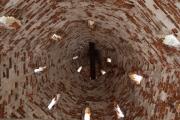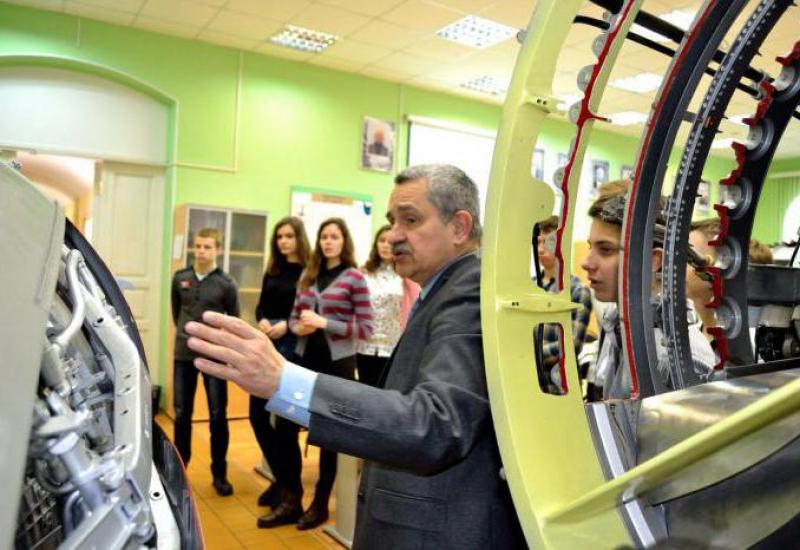The Alexandrovsky Women's Monastery begins services on April 7. St. Alexander Monastery - Suzdal - history - catalog of articles - love without conditions. Venerable Cornelius of Alexandrovsky
On the northern outskirts of the Moscow region, in the village of Maklakovo, 30 kilometers from the regional center of Taldom, there is the Alexander Convent, which has a history of more than a century. The monastery, which flourished until 1917, fell into disrepair during Soviet times. Now she is experiencing her rebirth...
In October 1888, at the Borki railway station, several carriages of the imperial train derailed and overturned. A number of people accompanying Alexander III died or were seriously injured, but the king himself and his children remained unharmed. This event was marked by the appearance in different parts of Russia of churches and monasteries dedicated to the heavenly patron of the emperor. Thus, in 1892, the Kalyazin merchant Ivan Danilovich Bachurin petitioned for the construction of a temple in the name of the blessed Prince Alexander Nevsky with an almshouse and an orphanage on his property near the village of Maklakovo, Kalyazinsky district, Tver province. On October 4, 18921, the foundation stone of a three-altar church took place here. At the same time, a house church was built in the two-story house, consecrated on March 16, 1896 in honor of the icon of the Mother of God “Quench My Sorrows,” brought from Athos. The same Bachurin petitioned for permission to open a women’s community at the church, the head of which was the nun of the Kazan Vyshnevolotsky Monastery Adrian. For a short time, priests Feodor Kolokolov and Pyotr Mozhzhukhin served in Maklakovo. Then, by decree of the Synod of June 15, 1896, an independent clergy was established at the Alexander Nevsky community, consisting of a priest and a psalm-reader. Archpriest Nikanor SudnitsynThe first priest of the community was Nikanor Vasilyevich Sudnitsyn, my great-great-great-grandfather.
He was born in 1835 in the village of Sknyatin, Kalyazinsky district, Tver province, into the family of a priest. After graduating from the Tver Theological Seminary, he was ordained a priest and assigned to the Sknyatinskaya Church of the Nativity of the Virgin Mary (1861), where he served for 35 years - until his appointment to the Alexander women's community. In Sknyatyn, Father Nikanor was actively involved in educational activities. “In 1871, the diocesan authorities expressed gratitude to him for teaching catechetical teachings. 1875, August 30, he was given the blessing of the Holy Synod without a diploma. (...) 1889, March 23, the blessing of the Holy Synod with a diploma was given a second time.”2 With special zeal, for 27 years he fulfilled the position of teacher of the law at the Sknyatinsky Zemstvo School (since 1869), as well as other responsible positions - confessor of the deanery, dean, employee of the Tver diocesan trusteeship of the poor with the spiritual title, having received, among other awards, a pectoral golden cross and Order of St. Anne, 3rd degree.
In 1897, the nun of the Tver Nativity of Christ Monastery Izmaragda, the niece of I. D. Bachurin, was appointed abbess of the community. The houses for the clergy were already ready and the construction of the temple was being completed. Its first Nikolsky chapel was consecrated on August 30, 1897 by priest Nikanor Sudnitsyn. Soon, next to the temple, a four-tiered stone bell tower with ten bells rose (the largest weighed 90 pounds).
In his new place, Father Nikanor continued to be actively involved in educational activities. Almost immediately after the consecration of the temple, he began to conduct extra-liturgical interviews and religious readings here. On January 10, 1898, a parish school was opened in the village, the head and teacher of which was Father Nikanor, and the first teacher was his sister-in-law Vera Ivanovna Sretenskaya, who completed a course at the Tsarskoye Selo Women's School of the Theological Department.
On May 26, 1901, in the Trinity Cathedral of the Kalyazin Monastery, Archbishop of Tver and Kashinsky Dimitry elevated Father Nikanor to the rank of archpriest3. After serving in Maklakovo for two more years and celebrating his 70th birthday, Archpriest Nikanor Sudnitsyn left the staff on August 3, 1905 and soon died.
The community, transformed into a monastery, had its own courtyard in St. Petersburg, where about 40 nuns lived. In 1910, a wooden church was built there in the name of the martyrs Vera, Nadezhda and Lyubov and their mother Sophia, and in 1912 a stone church was founded in the name of St. Alexis, Metropolitan of Moscow. There was a parochial school in the courtyard (not preserved).
According to data for 1913, the Alexander Monastery consisted of 8 nuns, 50 ryassophore novices and 60 living on probation. The monastery had quite a lot of land: Ivan Danilovich Bachurin took care of this too.
After the revolution, Abbess Izmaragda, who ruled the monastery for almost a quarter of a century, was arrested and died in Tver prison. The cathedral stood closed for a long time, gradually collapsing; wall paintings made by masters of the St. Petersburg Academy of Arts were lost in it. The stone two-story nursing building, where the house church was located, was converted into a hospital, then into a recreation center. The abbot's building housed a school. During perestroika, due to the lack of children, it was closed, and the building became private property. The remaining buildings were given over to housing; one of them had a post office.
In 1993, restoration of the monastery began. First, the parish of the Alexander Church was registered in Maklakov, and in 1996 the monastery itself opened.
A lot has changed here since then. The restoration of the temple is underway, a sister's building, three cell houses, and a number of outbuildings have been built. The house church was also restored. The same building housed a refectory, icon painting, ceramic and sewing workshops, a library, and sisters’ cells. However, in the winter of 2000, the building burned down. Many people and organizations responded to the sisters' request for help. And in 2000, the consecration of a new wooden church in honor of the icon of the Mother of God “Quench my sorrows” took place.
In memory of Abbess Izmaragda and the clergy of the monastery and in commemoration of the centenary of the monastery, a cross was erected at the altar of the Alexander Church. Unfortunately, the monastery cemetery has not been preserved, and there are no graves left of those to whom the Alexander Monastery owes its birth and prosperity - Ivan Danilovich Bachurin and Archpriest Nikanor Sudnitsyn.
A. N. Surkov, Moscow
Pilgrimage trips to the Alexander Nevsky Convent in the village. Maklakovo
On the bank of the Kamenka River, high above the ravine, stands the white-stone Alexander Monastery. Around him are huge black elm trees, framing the bell tower tent. Behind the bell tower, the five domes of the Church of the Ascension are visible, and a wide span of the holy gates, which are an octagon with a dome, leads to the entrance to the monastery.
In ancient times, the Alexander Monastery was called the Alexander Great Lavra and preserved the memory of the Suzdal princesses buried here. The origin of the name Big or Great Lavra is associated with the name of Alexander Nevsky. According to the chronicles, Alexander bequeathed the construction of the monastery before the battle with the German knights in 1240. The purpose of the monastery was charitable - to provide shelter and food for widows and orphans left without breadwinners after the Tatar invasions of Suzdal.

The wooden church could not withstand the destructive onslaught of the aggressors, and was burned by the Poles in 1608-1610. All that was preserved after the burning were tombstones with an inscription about the burial here of two princesses, Maria and Agrippina. Several decades later, at the request of the abbess of the monastery to Tsar Peter Alekseevich, construction of a new stone church began.
In 1695, at the expense of the mother of Peter 1, Tsarina Natalya Kirrilovna, a church, called the Ascension, and a bell tower were built. In the 18th century, a gate appeared in the southern part of the monastery and a fence decorated with turrets, erected by the Suzdal mason Gryaznov. In 1764, the convent was abolished, and the church became publicly accessible - a parish.

Experts attribute the church building to the suburban architecture of Suzdal, which is characterized by buildings in the form of tall cubes with windows on the facades and platbands on the first and second tiers. The center of the facades is decorated with portals with stone beads. A porch is attached to the western part of the church, which leads to the tomb. From the tomb you can get to the winter temple, located on the north side of the building. The church is protected from above by a hipped roof, which is topped with five domes.

The appearance of the church shows common features with the Peter and Paul Church, but there are also differences. Thus, traditional pilasters are absent, the windows are placed freely and decorated with figured columns, which later appeared on many Suzdal churches, and the height of the drums on which the domes stand is increased. The general appearance of the church is monumental and strict, because it was originally intended for the ensemble of the Alexander Monastery.
The bell tower next to the church is quite unconventional compared to other Suzdal bell towers. It is an octahedron placed on a low cube, ending with a high tent. A unique feature of the bell tower is the complete absence of decorations on the facades, which gives it a particularly strict cleanliness.
The holy gate is also built without frills. This is a simple gate with one span, on which are placed octagons, decorated with a dome.
The main losses in the architectural appearance of the once large monastery include the almost complete destruction of the fence and only partial preservation of the cells.
The view of the monastery is very picturesque, and many artists immortalized it in their works:



If you are planning a trip to Suzdal, be sure to take a walk in the vicinity of the monastery. Its grandeur and the beauty of the surrounding nature will inspire you too. We invite you to stay at our hotel "Suzdal Inn".
Address: Suzdal, st. Gasteva
Date of publication or update 12/15/2017
Alexander Convent in Maklakovo
Address of the Alexander Monastery: Moscow region, Taldomsky district, village. Maklakovo.
How to get to the Alexander Monastery.
Travel by public transport: from Savelovsky station to Taldom station.
Bus schedules are in useful links.
How to get to the Alexander Monastery by car: along Dmitrovskoe highway.
View all monasteries in the Moscow region on the Yandex map.
Among several dozen monasteries in the Moscow region, along with large and famous monasteries, there were and are small and even very small ones, but their religious service to people remains important and necessary. Now it is difficult to say when the attitude towards such modest monasteries was more respectful: in the tsarist period or at the beginning of the 21st century.
The Alexander Convent was actually created at the very end of the 19th century. on the estate and at the expense of the Kalyazin merchant I.D. Bachurina. The monastery was built in gratitude to the Lord God for delivering Emperor Alexander III and members of his family from death during the crash of the royal train on October 17, 1888.
First, in 1895, a women's community was opened in the village of Maklakovo, which was renamed a monastery in 1906.
A magnificent large stone cathedral in the name of St. Alexander Nevsky (consecrated in 1897) and a house church in honor of the icon of the Mother of God “Assuage my sorrows” (consecrated in 1896) were built in the monastery; both of them were erected at the expense of the merchant I.D. . Bachurina.
A stone four-tier bell tower was erected next to the cathedral in 1898.
The monastery complex included numerous different buildings, which were surrounded by a stone fence.
The main shrine of the monastery was the locally revered icon “Quiet My Sorrows,” which was sent here from Athos. Every year on patronal holidays, religious processions were held in the monastery, attracting a large number of pilgrims, for whom a hotel was built in the monastery.
A parish school has been operating at the monastery since 1898.
In 1927-1932 the last nuns were forced to leave the monastery, which was finally closed in the early 1930s. The monastery buildings housed a hospital, a school, a post office, and some of the premises were given over to housing.
In 1933, a parish church was opened in the name of the holy noble prince Alexander Nevsky.
In 1996, the Alexander Convent was revived. Both churches are operating in the monastery again: in the name of Alexander Nevsky and in honor of the icon “Quench My Sorrows”.
In the monastery, the sisters paint icons, perform artistic wood carvings, work in the garden, and perform other obediences in the monastery household.
Since 1998, when pilgrims and even groups of pilgrims from different cities and villages began to come to the monastery, the sisters began to conduct excursions, show spiritual performances and videos on Orthodox topics.
Not all of the buildings in the monastery have been preserved; some of them were dismantled during the Soviet period.
In addition to the large cathedral in the name of the Holy Blessed Prince Alexander Nevsky and the house frame in honor of the icon of the Mother of God “Quench My Sorrows,” a stone four-tiered bell tower, a cell building and a number of other buildings have been preserved from the monastery buildings.
Using materials from the book “Monasteries of the Moscow Region”.
The Holy Trinity Stefano-Makhrishchi Monastery was founded in the 1350s by the Monk Stephen, a native of the Kiev-Pechersk Monastery.
In the 16th century, the stone Church of the Holy Trinity was built here. In the same century, the incorrupt relics of St. Stephen were found, over which a church was built in his honor. In the 18th century, a stone fence and the Church of St. Sergius of Radonezh were built over the eastern gates, and in the 19th century, the Church of the Supreme Apostles Peter and Paul over the northern gates and fraternal buildings. At the same time, a three-tier bell tower was added to the Trinity Church.
In 1900, a shelter for orphans and children of surrounding residents was established in the monastery. In 1922 the monastery was closed.
In 1993, the work of the monastery was resumed as the work of the monastery of the Assumption Convent in the city of Alexandrov. In 2004, the Holy Trinity Stefano-Makhrishchi Monastery acquired stauropegial status.
Holy Trinity Stefano-Makhrishchi Monastery
The Holy Trinity Stefano-Makhrishchsky Convent is located in a picturesque place on the Molokcha River in the village of Makhra, Alexandrovsky district, Vladimir region. This monastery was founded by the Monk Stefan, who came from the walls of the Kiev-Pechersk Monastery. Ivan IV the Terrible, Moscow saints and Poles of the Time of Troubles, Sergius of Radonezh, His Holiness Patriarch of Moscow and All Rus' Alexy II and other famous personalities visited the walls of the monastery. The monastery is always open to pilgrims and guests from different regions!
Holy Dormition Monastery
The founder of the Holy Dormition Monastery is Elder Lucian. The convent appeared in the 17th century on the territory of the Assumption Church, built by Ivan the Terrible in 1564. In addition to this church, the monastery has another ancient temple, reminiscent of the Tsar’s stay here - the Trinity Cathedral with an unusual bell tower, unique “Vasilievsky” doors from the St. Sophia Church and the miraculous Vladimir Icon of the Mother of God.
The monastery sacredly honors the memory of Father Cornelius, who was buried under the altar of the cathedral. Every year on August 11th a funeral service is held for it. The Sacristy houses many landmarks from the 17th and 18th centuries, donated to the monastery by royalty and other persons. The library contains a large number of synodics and manuscripts from the 16th and 17th centuries. There is a craft workshop, a school, a hospital and a hotel at the monastery.
Alexander Convent- located on the left bank of the Kamenka River in Suzdal, according to legend, was founded in 1240 by Alexander Nevsky. The ancient monuments of the monastery have not survived to this day. The Church of the Ascension of the Lord with a bell tower was built in 1695 at the expense of Tsarina Natalya Kirillovna, mother of Peter I.
In 1764, during the secularization of the lands by Catherine II, the Alexander Monastery was abolished with the conversion of the cathedral into the parish church of the city. In 2006, it was reopened as a monastery of the Vladimir-Suzdal diocese. The rector (since 2011) is Abbot Abel (Urgalkin).
Ascension Church It is a tall two-tiered quadrangle, topped with five domes. On the eastern side, a large apse adjoins the quadrangle, on the northern side there is a warm aisle, and on the eastern side there is a porch. The windows are decorated with carved frames with simple columns in the first tier and figured ones in the second. Figured columns are also used in the decoration of high, skyward drums.
Ascension Church with bell tower
Octagonal tent pillar bell towers placed on a low quadrangle, to which a wooden staircase is attached. Its walls are practically devoid of decor, which makes it unique among the Suzdal tent-roofed bell towers. A modest decoration of the upper part is the carved frame of the arched openings and the platbands above the dormer windows.
In the first half of the 18th century, a low fence was built around the monastery, decorated with decorative turrets stylized as defensive towers. At the same time, the Holy Gate with a two-tier turret appeared, reminiscent of the Holy Gate of the Trinity Monastery, now part of the ensemble of the Deposition of the Robe Monastery. This coincidence is not accidental: the fence and towers of the Alexander Monastery were erected under the leadership of Ivan Gryaznov, who participated in the construction of the Trinity and Robe Monasteries at the end of the 17th century.
Source
- Suzdal. Alexander Monastery
- Description of the monasteries of Suzdal. Photos.














